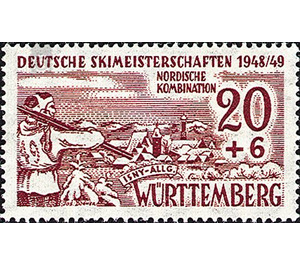German Ski Championships 1948/49 in Isny, Allgäu - Germany / Western occupation zones / Württemberg-Hohenzollern 1949 - 20 Pfennig
Theme: Sports & Games
| Country | Germany / Western occupation zones / Württemberg-Hohenzollern |
| Issue Date | 1949 |
| Face Value | 20.00 |
| Perforation | K 14:14 1/4 |
| Stamp Type | Postage stamp |
| Item Type | Stamp |
| Chronological Issue Number | 39 |
| Chronological Chapter | GER-FRW |
| SID | 381016 |
| In 3 Wishlists | |
The stamp belongs to the issue of February 11, 1949 on the occasion of the German Ski Championships 1948/49 in Isny im Allgäu, which shows views of the city. The motif shows a skier in the foreground looking at Isny. In the city you can see the Blaserturm, the Espantor and the town hall. The Blaserturm consists of a square base from the 16th century and an octagonal tower tower with a belfry. Above this, a little bit withdrawn, an onion dome. The tower was formerly used as a watchtower, but today used as a library. The first mentioned in 1413 Espantor, with a trapezoidal plan, was probably built in the 13th century. It got its name from the term "Espan", the pasture, festival or playground.


